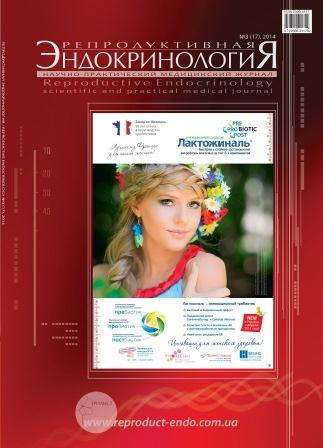Adhesive disease of the pelvic organs and abdominal cavity
DOI:
https://doi.org/10.18370/2309-4117.2014.17.22-28Keywords:
unification, adhesive disease, pelvic organs and abdominal cavityAbstract
This review presents recent data of domestic and foreign literature on the relevance of the problem of adhesive disease pelvic and abdominal cavities. Incidence of intra-abdominal adhesions varies from 67 to 93% after abdominal surgery, and is almost 97% after open gynecologic procedures. Most often adhesions are formed after operations on the abdominal organs; bleeding into the abdominal cavity; inflammation in the peritoneal cavity; in the presence of foreign bodies in the abdominal cavity; at a local tissue ischemia. Leading point of pathogenesis of adhesive disease is inflammation of the peritoneum, accompanied by disorders of local tissue metabolism, and desquamation of the mesothelium and loss of fibrin, that is leads to agglutination of serous membranes. Operations, often resulting in adhesive obstruction include surgery of the colon and rectum, gynecological surgery and emergency appendectomy.
References
- Mikhin, I.V. «Minimally invasive techniques in the diagnosis, treatment and prevention of abdominal adhesive disease (clinical and experimental research).» Volgograd State Medical University. Author. dis. .. Dr. med. Sciences, (2007):1-3.
- Bejenari, V.F. Ailamzyan, E.K. Baylyuk, E.N. Tsypurdeeva, A.A. «Etiology, pathogenesis and prevention of adhesions in surgery of the pelvic.» Russian Obstetrician-Gynecologist Gazette,2(2011):90-100.
- Matveev, M.L. Аrutyunyan, D.Y. «Intraperitoneal adhesions – underestimated problem surgery (review).» Endoscopic surgery,5(2007):60-69.
- Kulakov, V.I. Adamian, L.V. Mynbaev, O.A. «Postoperative adhesions (etiology, pathogenesis and prevention).» M.: Medical, (1998):528 p.
- Netyaga,A.A. Lipatov, V.A. Gaidukova, L.V. «Study of regeneration processes of the peritoneum in isolated conditions.» Kursk scientific and practical messenger «Human and its health»,2(2005):57-63.
- Krasil’nikov, D.M. «Diagnosis and treatment of postoperative adhesive ileus.» Kazan Medical Journal,78(3)(1994):207-210.
- Patent for useful model № 49508 Ukraine, IPC (2009) A61V 10/00. Method of predicting recurrence of adhesive disease / Vansovych, V.E., Kotik, Y.M.; applicant and patentee Odessa State Medical University, № u 2010 00144; appl. 11.01.2010; publ. 26.04,2010, Bull. Number 8.
- Bejenari, V.F. Baylyuk, E.N. Tsypurdeeva, A.A. «The clinical significance of adhesions barriers in preventing the formation of adhesions in gynecological patients.» Journal of obstetric and gynecological diseases,58(2009):M3.
- Popov, A.A. «Preventing the formation of adhesions in gynecological patients.» Journal of obstetric and gynecological diseases,58(5)(2009):M9.
- Chekmazov, I.A. «Adhesive disease of the abdominal cavity (pathogenesis, clinical manifestations, diagnosis, treatment and prevention).» Author. dis. ... Dr. med. Sciences. Moscow, 48(2004).
- Monk, B.J. Berman, M.L. Montz, F.J. «Adhesions after extensive gynecologic surgery: Clinical significance, etiology and prevention.» Am J Obstet Gynecol,170(1994):1396-1403.
- Coleman, M.G. McLain, A.D. Moran, B.J. «Impact of previous surgery on time taken for incisions and division of adhesions during laparotomy.» Dis Colon Rectum,43(2000):1297-1299.
- van der Krabben, A.A. Dijkstra, F.R. Nieuwenhuijzen, M. et al. «Morbidity and mortality of inadvertent enterotomy during adhesiotomy.» Br J Surg,87(2000):467-471.
- Menzies, D. «Peritoneal adhesions: Incidence, cause, and prevention.» Surg Annu Surg,24(1992):27-45.
- Luijendijk, R.W. de Lange, D.C.D. Wauters, C.C.A.P. et al. «Foreign material in postoperative adhesions.» Ann Surg,223(1996):242-248.
- Liakakos, T. Thomakos, N. Fine, P.M. et al. «Peritoneal adhesions: ethiology, pathophysiology, and clinical significance. Recent advances in preventionand management.» Dig Surg,18(2001):260-273.
- Duffy, D.M. di Zerega, G.S. «Adhesion controversies: Pelvic pain as a cause of adhesions, crystalloids in preventing them.» J Reprod Med,41(1996):19-26.
- De Cherney, A.H. di Zerega, G.S. «Clinical problem of intraperitoneal postsurgical adhesion formation following general surgery and the use of adhesion prevention barriers.» Surg Clin North Am,77(1997):671-688.
- Drollette, C.M. Badawy, S.Z.A. «Pathophysiology of pelvic adhesions: Modern trends in preventing infertility.» J Reprod Med,37(1992):107-122.
- di Zerega, G.S. «Biochemical events in peritoneal tissue repair.» Eur J Surg Suppl,577(1997):10-16.
- Holmdahl, L. «The role of fibrinolysis in adhesion formation.» Eur J Surg Suppl,577(1997):24-31.
- Risberg, B.O. «Adhesions: Preventive strategies.» Eur J Surg Suppl,577(1997):32-39.
- Duffy, D.M. di Zerega, G.S. «Is peritoneal closure necessary?» Obstet Gynecol Surv,49(1994):817-822.
- Stricker, B. Blanco, J. Fox, H.E. «The gynecologic contribution to intestinal obstruction in females.» J Am Coll Surg,178(1994):617-620.
- 43. Frankfurter, D. De Cherney, A.H. «Pelvic adhesive disease.» Postgrade Obstet Gynecol,16(1996):1-5.
- Gutt, C.N. Oniu, T. Schemmer, P. et al. «Fewer adhesions induced by laparoscopic surgery?» Surg Endosc,18(2004):898-906.
- Bergstrom, M. Falk, P. Holmdahl, L. «CO2 promotes plasminogen activator inhibitor type 1 expression in human mesothelial cells.» Surg Endosc,17(11)(2003):1818-1822.
- Lundorff, P. Hahlin, M. Kallfelt, B. et al. «Adhesion formation after laparoscopic surgery in tubal pregnancy: A randomized trial versus laparotomy.» Fertil Steril,55(1991):911-915.
- Trew, G. «Consensus in adhesion reduction management.» Obstet Gynaecol,6(2004):2.
Downloads
Published
How to Cite
Issue
Section
License
Copyright (c) 2014 В. Л. Дронова, Е. В. Луценко, Р. С. Теслюк, М. И. Насташенко

This work is licensed under a Creative Commons Attribution 4.0 International License.
Authors who publish with this journal agree to the following terms:
- Authors retain copyright and grant the journal right of first publication with the work simultaneously licensed under a Creative Commons Attribution License that allows others to share the work with an acknowledgement of the work's authorship and initial publication in this journal.
- Authors are able to enter into separate, additional contractual arrangements for the non-exclusive distribution of the journal's published version of the work (e.g., post it to an institutional repository or publish it in a book), with an acknowledgement of its initial publication in this journal.







